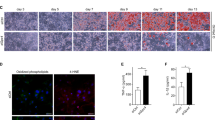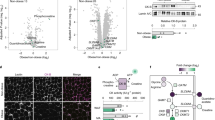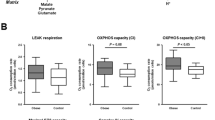Abstract
Objectives:
Cytochrome oxidase (COX) dysfunction is associated with mitochondrial oxidative stress. We determined the association between COX expression, obesity and type 2 diabetes.
Subjects/methods:
COX4I1 and COX10 genes were measured in monocytes of 24 lean controls, 31 glucose-tolerant and 67 diabetic obese patients, and 17 morbidly obese patients before and after bariatric surgery. We investigated the effect of caloric restriction and peroxisome proliferator-activated receptor (PPAR) agonist treatment on Cox in obese diabetic mice, and that of diet-induced insulin resistance in Streptozotocin-treated mice.
Results:
Low COX4I1 was associated with type 2 diabetes in obese patients, adjusting for age, gender, smoking, interleukin-6 and high-sensitivity C-reactive protein, all related to metabolic syndrome (MetS; odds ratio: 6.1, 95% confidence interval: 2.3–16). In contrast, COX10 was low in glucose-tolerant and diabetic obese patients. In morbidly obese patients, COX4I1 was lower in visceral adipose tissue collected at bariatric surgery. In their monocytes, COX4I1 decreased after bariatric surgery, and low COX4I1 at 4 months was associated with MetS at 7 years. In leptin-deficient obese diabetic mice, Cox4i1 was low in white visceral adipose tissue (n=13; P<0.001) compared with age-matched lean mice (n=10). PPARγ-agonist treatment (n=13), but not caloric restriction (n=11), increased Cox4i1 (P<0.001). Increase in Cox4i1 depended on the increase in glucose transporter 4 ( Glut4) expression and insulin sensitivity, independent of the increase in blood adiponectin. In streptozotocin-treated mice (three groups of seven mice, diet-induced insulin resistance decreased Cox4i1 and Glut4 (P<0.001 for both).
Conclusion:
COX4I1 depression is related to insulin resistance and type 2 diabetes in obesity. In peripheral blood monocytes, it may be a diagnostically useful biomarker.
This is a preview of subscription content, access via your institution
Access options
Subscribe to this journal
Receive 12 print issues and online access
$259.00 per year
only $21.58 per issue
Buy this article
- Purchase on Springer Link
- Instant access to full article PDF
Prices may be subject to local taxes which are calculated during checkout




Similar content being viewed by others

References
Alberti KG, Eckel RH, Grundy SM, Zimmet PZ, Cleeman JI, Donato KA et al. Harmonizing the metabolic syndrome: a joint interim statement of the International Diabetes Federation Task Force on Epidemiology and Prevention; National Heart, Lung, and Blood Institute; American Heart Association; World Heart Federation; International Atherosclerosis Society; and international association for the Study of Obesity. Circulation 2009; 120: 1640–1645.
Grundy SM . Obesity, metabolic syndrome, and cardiovascular disease. J Clin Endocrinol Metab 2004; 89: 2595–2600.
Grundy SM, Brewer HB Jr, Cleeman JI, Smith SC Jr, Lenfant C . Definition of metabolic syndrome: report of the National Heart, Lung, and Blood Institute/American Heart Association conference on scientific issues related to definition. Arterioscler Thromb Vasc Biol 2004; 24: e13–e18.
Muntner P, He J, Chen J, Fonseca V, Whelton PK . Prevalence of non-traditional cardiovascular disease risk factors among persons with impaired fasting glucose, impaired glucose tolerance, diabetes, and the metabolic syndrome: analysis of the Third National Health and Nutrition Examination Survey (NHANES III). Ann Epidemiol 2004; 14: 686–695.
Ridker PM, Rifai N, Stampfer MJ, Hennekens CH . Plasma concentration of interleukin-6 and the risk of future myocardial infarction among apparently healthy men. Circulation 2000; 101: 1767–1772.
Ridker PM, Buring JE, Cook NR, Rifai N . C-reactive protein, the metabolic syndrome, and risk of incident cardiovascular events: an 8-year follow-up of 14 719 initially healthy American women. Circulation 2003; 107: 391–397.
Holvoet P, Mertens A, Verhamme P, Bogaerts K, Beyens G, Verhaeghe R et al. Circulating oxidized LDL is a useful marker for identifying patients with coronary artery disease. Arterioscler Thromb Vasc Biol 2001; 21: 844–848.
Holvoet P, Harris TB, Tracy RP, Verhamme P, Newman AB, Rubin SM et al. Association of high coronary heart disease risk status with circulating oxidized LDL in the well-functioning elderly: findings from the Health, Aging, and Body Composition study. Arterioscler Thromb Vasc Biol 2003; 23: 1444–1448.
Holvoet P, Kritchevsky SB, Tracy RP, Mertens A, Rubin SM, Butler J et al. The metabolic syndrome, circulating oxidized LDL, and risk of myocardial infarction in well-functioning elderly people in the health, aging, and body composition cohort. Diabetes 2004; 53: 1068–1073.
Holvoet P, Lee DH, Steffes M, Gross M, Jacobs DR Jr . Association between circulating oxidized low-density lipoprotein and incidence of the metabolic syndrome. JAMA 2008; 299: 2287–2293.
Furukawa S, Fujita T, Shimabukuro M, Iwaki M, Yamada Y, Nakajima Y et al. Increased oxidative stress in obesity and its impact on metabolic syndrome. J Clin Invest 2004; 114: 1752–1761.
Antonopoulos AS, Margaritis M, Coutinho P, Shirodaria C, Psarros C, Herdman L et al. Adiponectin as a link between type 2 diabetes mellitus and vascular NADPH-oxidase activity in the human arterial wall: the regulatory role of perivascular adipose tissue. Diabetes 2014. e-pub ahead of print 31 December 2014.
Liu Y, Palanivel R, Rai E, Park M, Gabor TV, Scheid MP et al. Adiponectin stimulates autophagy and reduces oxidative stress to enhance insulin sensitivity during high-fat diet feeding in mice. Diabetes 2015; 64: 36–48.
Reilly MP, Lehrke M, Wolfe ML, Rohatgi A, Lazar MA, Rader DJ . Resistin is an inflammatory marker of atherosclerosis in humans. Circulation 2005; 111: 932–939.
Holvoet P, Vanhaecke J, Janssens S, Van de Werf F, Collen D . Oxidized LDL and malondialdehyde-modified LDL in patients with acute coronary syndromes and stable coronary artery disease. Circulation 1998; 98: 1487–1494.
Wallace DC . A mitochondrial paradigm of metabolic and degenerative diseases, aging, and cancer: a dawn for evolutionary medicine. Annu Rev Genet 2005; 39: 359–407.
Poyton RO, McEwen JE . Crosstalk between nuclear and mitochondrial genomes. Annu Rev Biochem 1996; 65: 563–607.
Villani G, Attardi G . In vivo control of respiration by cytochrome c oxidase in wild-type and mitochondrial DNA mutation-carrying human cells. Proc Natl Acad Sci USA 1997; 94: 1166–1171.
Njajou OT, Kanaya AM, Holvoet P, Connelly S, Strotmeyer ES, Harris TB et al. Association between oxidized LDL, obesity and type 2 diabetes in a population-based cohort, the Health, Aging and Body Composition Study. Diabetes Metab Res Rev 2009; 25: 733–739.
Park K, Gross M, Lee DH, Holvoet P, Himes JH, Shikany JM et al. Oxidative stress and insulin resistance: the coronary artery risk development in young adults study. Diabetes Care 2009; 32: 1302–1307.
Arnold S . Cytochrome c oxidase and its role in neurodegeneration and neuroprotection. Adv Exp Med Biol 2012; 748: 305–339.
Arnold S . The power of life—cytochrome c oxidase takes center stage in metabolic control, cell signalling and survival. Mitochondrion 2012; 12: 46–56.
Williams SL, Valnot I, Rustin P, Taanman JW . Cytochrome c oxidase subassemblies in fibroblast cultures from patients carrying mutations in COX10, SCO1, or SURF1. J Biol Chem 2004; 279: 7462–7469.
Luo M, Guan X, Luczak ED, Lang D, Kutschke W, Gao Z et al. Diabetes increases mortality after myocardial infarction by oxidizing CaMKII. J Clin Invest 2013; 123: 1262–1274.
Cummings DE, Overduin J, Foster-Schubert KE . Gastric bypass for obesity: mechanisms of weight loss and diabetes resolution. J Clin Endocrinol Metab 2004; 89: 2608–2615.
Klein S, Burke LE, Bray GA, Blair S, Allison DB, Pi-Sunyer X et al. Clinical implications of obesity with specific focus on cardiovascular disease: a statement for professionals from the American Heart Association Council on Nutrition, Physical Activity, and Metabolism: endorsed by the American College of Cardiology Foundation. Circulation 2004; 110: 2952–2967.
Sjostrom L, Lindroos AK, Peltonen M, Torgerson J, Bouchard C, Carlsson B et al. Lifestyle, diabetes, and cardiovascular risk factors 10 years after bariatric surgery. N Engl J Med 2004; 351: 2683–2693.
Hulsmans M, Geeraert B, De Keyzer D, Mertens A, Lannoo M, Vanaudenaerde B et al. Interleukin-1 receptor-associated kinase-3 is a key inhibitor of inflammation in obesity and metabolic syndrome. PLoS One 2012; 7: e30414.
Mertens A, Verhamme P, Bielicki JK, Phillips MC, Quarck R, Verreth W et al. Increased low-density lipoprotein oxidation and impaired high-density lipoprotein antioxidant defense are associated with increased macrophage homing and atherosclerosis in dyslipidemic obese mice: LCAT gene transfer decreases atherosclerosis. Circulation 2003; 107: 1640–1646.
Verreth W, De KD, Pelat M, Verhamme P, Ganame J, Bielicki JK et al. Weight-loss-associated induction of peroxisome proliferator-activated receptor-alpha and peroxisome proliferator-activated receptor-gamma correlate with reduced atherosclerosis and improved cardiovascular function in obese insulin-resistant mice. Circulation 2004; 110: 3259–3269.
Ridderstrale M, Carlsson E, Klannemark M, Cederberg A, Kosters C, Tornqvist H et al. FOXC2 mRNA expression and a 5' untranslated region polymorphism of the gene are associated with insulin resistance. Diabetes 2002; 51: 3554–3560.
Pickl WF, Majdic O, Kohl P, Stockl J, Riedl E, Scheinecker C et al. Molecular and functional characteristics of dendritic cells generated from highly purified CD14+ peripheral blood monocytes. J Immunol 1996; 157: 3850–3859.
Salio M, Cerundolo V, Lanzavecchia A . Dendritic cell maturation is induced by mycoplasma infection but not by necrotic cells. Eur J Immunol 2000; 30: 705–708.
Cynis H, Kehlen A, Haegele M, Hoffmann T, Heiser U, Fujii M et al. Inhibition of glutaminyl cyclases alleviates CCL2-mediated inflammation of non-alcoholic fatty liver disease in mice. Int J Exp Pathol 2013; 94: 217–225.
Fujii M, Shibazaki Y, Wakamatsu K, Honda Y, Kawauchi Y, Suzuki K et al. A murine model for non-alcoholic steatohepatitis showing evidence of association between diabetes and hepatocellular carcinoma. Med Mol Morphol 2013; 46: 141–152.
Geeraert B, De Keyzer D, Davey PC, Crombe F, Benhabiles N, Holvoet P . Oxidized low-density lipoprotein-induced expression of ABCA1 in blood monocytes precedes coronary atherosclerosis and is associated with plaque complexity in hypercholesterolemic pigs. J Thromb Haemost 2007; 5: 2529–2536.
Hulsmans M, De Keyzer D, Holvoet P . MicroRNAs regulating oxidative stress and inflammation in relation to obesity and atherosclerosis. FASEB J 2011; 25: 2515–2527.
Livak KJ, Schmittgen TD . Analysis of relative gene expression data using real-time quantitative PCR and the 2(-Delta Delta C(T)) Method. Methods 2001; 25: 402–408.
Vandesompele J, De Preter K, Pattyn F, Poppe B, Van Roy N, De Paepe A et al. Accurate normalization of real-time quantitative RT-PCR data by geometric averaging of multiple internal control genes. Genome Biol 2002; 3, RESEARCH0034.
Wang CH, Wang CC, Huang HC, Wei YH . Mitochondrial dysfunction leads to impairment of insulin sensitivity and adiponectin secretion in adipocytes. FEBS J 2013; 280: 1039–1050.
Burkart EM, Sambandam N, Han X, Gross RW, Courtois M, Gierasch CM et al. Nuclear receptors PPARbeta/delta and PPARalpha direct distinct metabolic regulatory programs in the mouse heart. J Clin Invest 2007; 117: 3930–3939.
Hulsmans M, Geeraert B, Arnould T, Tsatsanis C, Holvoet P . PPAR agonist-induced reduction of Mcp1 in atherosclerotic plaques of obese, insulin-resistant mice depends on adiponectin-induced Irak3 expression. PLoS One 2013; 8: e62253.
Rindler PM, Crewe CL, Fernandes J, Kinter M, Szweda LI . Redox regulation of insulin sensitivity due to enhanced fatty acid utilization in the mitochondria. Am J Physiol Heart Circ Physiol 2013; 305: H634–H643.
Anderson EJ, Lustig ME, Boyle KE, Woodlief TL, Kane DA, Lin CT et al. Mitochondrial H2O2 emission and cellular redox state link excess fat intake to insulin resistance in both rodents and humans. J Clin Invest 2009; 119: 573–581.
Bonnard C, Durand A, Peyrol S, Chanseaume E, Chauvin MA, Morio B et al. Mitochondrial dysfunction results from oxidative stress in the skeletal muscle of diet-induced insulin-resistant mice. J Clin Invest 2008; 118: 789–800.
Kadenbach B, Ramzan R, Vogt S . Degenerative diseases, oxidative stress and cytochrome c oxidase function. Trends Mol Med 2009; 15: 139–147.
Fridovich I . Superoxide dismutases. An adaptation to a paramagnetic gas. J Biol Chem 1989; 264: 7761–7764.
Acknowledgements
We thank Roxane Menten for her excellent technical support. This work was funded by the Bijzonder Onderzoeksfonds of the KU Leuven (PF/10/014; Center of Excellence), by the Interdisciplinair Ontwikkelingsfonds—Kennisplatform (KP/12/009) and by the Fonds voor Wetenschappelijk Onderzoek-Vlaanderen (G0846.11 and Vascular Biology Network). MH is a postdoctoral fellow of the Fonds voor Wetenschappelijk Onderzoek-Vlaanderen.
Author information
Authors and Affiliations
Corresponding author
Ethics declarations
Competing interests
The authors declare no conflict of interest.
Additional information
Supplementary Information accompanies this paper on International Journal of Obesity website
Supplementary information
Rights and permissions
About this article
Cite this article
Van der Schueren, B., Vangoitsenhoven, R., Geeraert, B. et al. Low cytochrome oxidase 4I1 links mitochondrial dysfunction to obesity and type 2 diabetes in humans and mice. Int J Obes 39, 1254–1263 (2015). https://doi.org/10.1038/ijo.2015.58
Received:
Revised:
Accepted:
Published:
Issue Date:
DOI: https://doi.org/10.1038/ijo.2015.58
This article is cited by
-
Identification of key pathways and genes in polycystic ovary syndrome via integrated bioinformatics analysis and prediction of small therapeutic molecules
Reproductive Biology and Endocrinology (2021)
-
Senolytic CAR T cells reverse senescence-associated pathologies
Nature (2020)
-
Targeted Metabolomics Reveals Abnormal Hepatic Energy Metabolism by Depletion of β-Carotene Oxygenase 2 in Mice
Scientific Reports (2017)


